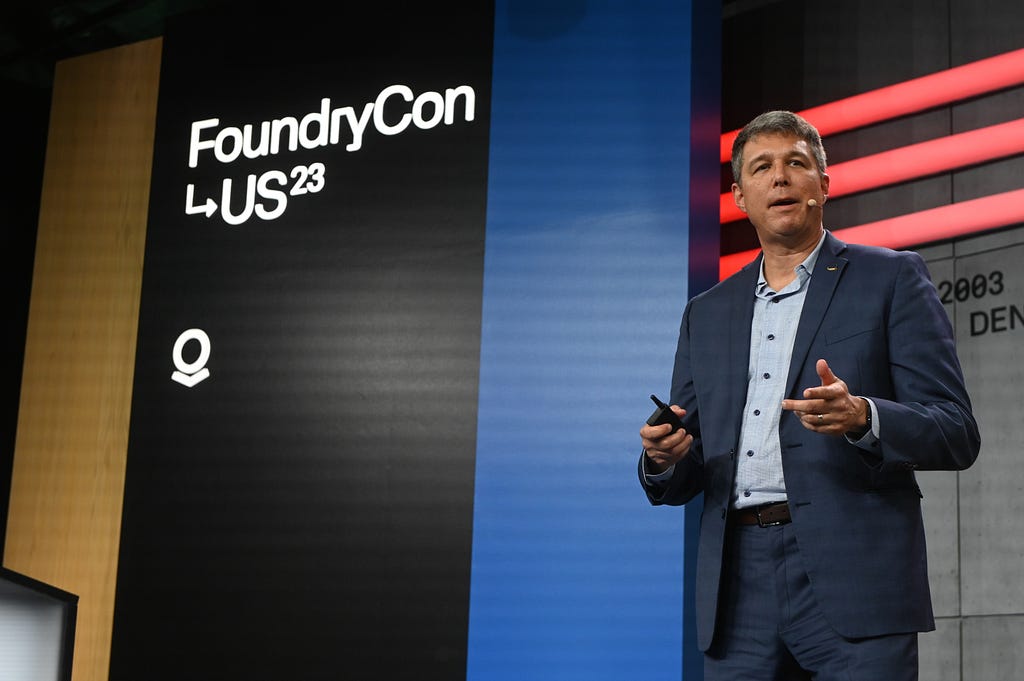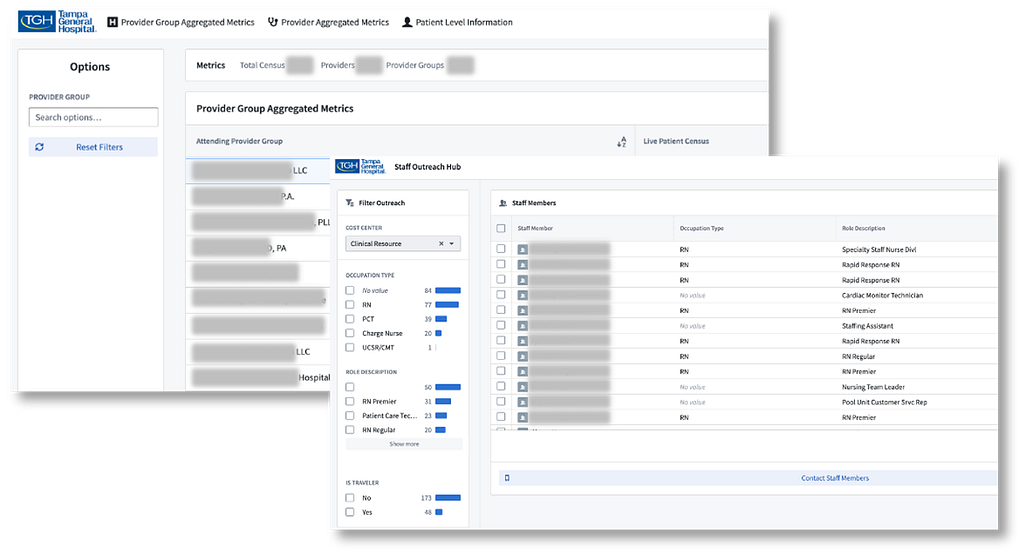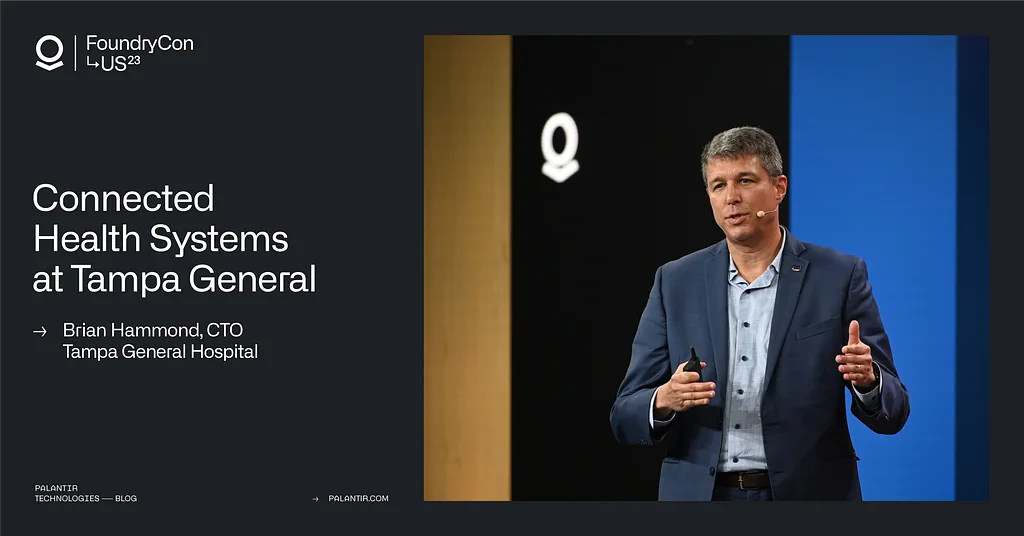Editor’s Note: At Foundrycon, Brian Hammond, Tampa General Hospital’s Chief Technology Officer, shared how TGH leveraged Foundry to operationalize data to drive a connected health system, improving outcomes for both health care providers and the patients they serve. Check out the full talk here.

Hospitals provide critical services to the broader communities they reside in. They’re not just places where people go for sudden medical emergencies; hospitals also serve as long-term care centers, surgery clinics, and even as shelter locations during natural disasters. To continually meet a community’s complex needs, hospital systems need the ability to track which equipment and staff are available, what needs those resources can help address, and how equipment and staff can surge during critical moments.
Tampa General Hospital (TGH) is one of the nation’s leading academic health systems with over 100 locations across the state of Florida. Management realized that access to data wasn’t an issue but making that data actionable — doing something useful with it — was easier said than done. In the words of Brian Hammond, CTO of Tampa General “We were data-rich, but information-poor.”
Realizing that Tampa General’s biggest opportunity lay in wielding its data effectively by connecting it to operational systems, Hammond and his team partnered with Palantir to ensure the hospital could meet its most challenging moments. This led to rapid outcomes across units where Palantir Foundry workflows were implemented, including:
- A 30% improvement in the nurse staffing ratio in affected units
- Improvements in the Post-Anesthesia Care Unit (PACU) including a 28% reduction in hold time
- PACU predictive model with 95% accuracy
- An application for real-time disaster response delivered in less than 24 hours in response to Hurricane Ian
The Connected Health System in Action
Tampa General Hospital’s broad reach and critical community presence as the region’s only Level I trauma center meant the hospital system filled a huge need in providing critical care for a sizable population. Yet the hospital system faced significant obstacles in the way of truly operational data-driven projects that could meet meaningful impact for the patients it served.
For one, data silos prevented teams from effectively leveraging the same base of information and building on top of insights. This could have knock-on effects. If, for example, a recovery ward had stale or incomplete data about a patient’s post-surgery condition because post-surgery data wasn’t easily available, this might have needlessly negatively impacted the patient’s aftercare. Second, the data platform Tampa General used required lots of maintenance work and lacked advanced capabilities. This meant wasted time for data analysts and limited ability to impact real-time decision-making. Finally, because there was no broad vision or strategy for what to do with Tampa General’s mountain of data, data teams around the organization ended up fielding ad hoc requests from different departments.

With Hammond in charge, Tampa General decided to create a vision for an integrated health-tech system and began to leverage Palantir Foundry to make that vision a reality. Tampa General envisioned a platform that could help analysts glean real-time performance information and enable them to provide recommendations to leadership for reducing bottlenecks and decreasing waste.
“Having all your data in one place is the solution that will merely help you get to the solution. The key is figuring out exactly what you want to do with your data, why you’re trying so hard to integrate and harmonize it.”
– Brian Hammond, CTO, Tampa General Hospital
The hospital was building toward a data platform that could support various AI and ML initiatives (e.g., predict when patient wait time might spike and automatically recommend shift optimizations to improve patient care) and serve as a foundation for bioinformatics and research.
Tampa General knew that digging through data for insights wasn’t a remedy; doing something with those insights, however, could prove significant. Since the hospital system engaged with Palantir, three important applications have emerged as the hospital continues on its journey to becoming a data led connected hospital system.
Clinical Staffing
Clinical staffing was the first pressing need in the Tampa General Hospital system, operating off a paper-based highly manual system. Data was entered by hand and quickly became stale as the census shifted throughout the day. This meant a delayed decision-making process due to an often-outdated understanding of what patient needs were and which appropriate care was immediately available.

Foundry was able to integrate and harmonize nursing schedules, patient information, and acuity levels, then automatically generate optimized schedules with staffing levels that responded as real-life variables changed. Confirmed changes would automatically inform staff to communicate scheduling shifts according to their availability. This insight and agility enabled TGH to move from reactive day-of planning to proactive planning days in advance. With this target workflow alone, TGH saved over $100k from optimized shift swaps, a 30% improvement in staff-to-patient ratio, and reduced friction due to reactive communication with staff.
Post-Anesthesia Care Unit (PACU)
TGH’s Post-Anesthesia Care Unit or PACU had to reconcile the availability of beds, staffing, and other necessary resources to critical needs at surgery centers. The existing process of assessing these needs also began on printouts and estimated predictions the morning of. However, inaccurate predictions often resulted in bottlenecks leading to longer hold times, and potential delays in life-saving procedures.

TGH was able to leverage a predictive model to forecast when patients would arrive and how long they would spend in the recovery unit to flex staff as needed. This model was able to predict needs days ahead of time with 95% accuracy, leading to a 28% decrease in average hold time and an 83% decrease in time spent by staff managing patient placement.
Hurricane Ian Response
In September 2022, the TGH system was bracing for the landfall of Hurricane Ian. With the Tampa metropolitan area predicted to face the brunt of landfall and the main hospital located in the main evacuation zone, the hospital system had to make the most of the five days it had before the storm hit. The hospital took precautions including a temporary sea-wall, however, it needed a data solution to handle the pressure on available staffing resources.

Teams were able to build a model in 24 hours that was able to provide a real time 360 view of patient counts per provider, responsive scenario planning for patient allocation, and an outreach module to mass contact TGH staff with personalized instruction in less than a minute. This solution allowed the hospital system to respond to storm related needs in real time, allocate resources where most needed, and ultimately connect patients to care. These workflows were repurposed for post-hurricane, day-to-day operations.
Success Factors
TGH was able to leverage Foundry where it delivered the greatest value, tasking it toward data-rich yet incredibly complex operational problems. Across the needs of hospital administration and rapid response to natural disasters, Foundry delivered rapid transformation at scale. However, this success was driven by a number of factors that optimized usage of the powerful product.
- Senior leadership was bought in on Foundry, with the Tampa General president and CEO in close alignment as well as a senior steering committee helping with governance and project prioritization
- Operational subject matter experts were key stakeholders and advocates for the platform, ensuring the end-user was driving change
- A mature integration team and analytics team were given the right tools to ramp up on Foundry
Foundry is a powerful tool, however, it’s most powerful when the organization has bought in. This may be challenging when navigating communication between different departments, facilities, or data fiefdoms. Yet the key is to ensure everyone is aligned on a strategy, and an ultimate goal of transformational change. Foundry and the Ontology can power it, and together we can deliver it.
If you’d like to learn more, please reach out here.
Connected Health Systems at Tampa General was originally published in Palantir Blog on Medium, where people are continuing the conversation by highlighting and responding to this story.
